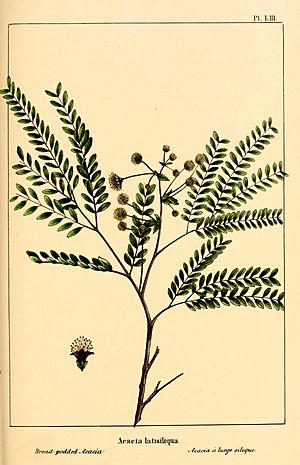False tamarind facts for kids
Quick facts for kids False tamarind |
|
|---|---|
 |
|
| Conservation status | |
| Scientific classification | |
| Kingdom: | |
| (unranked): | |
| (unranked): | |
| (unranked): | |
| Order: | |
| Family: | |
| Genus: |
Lysiloma
|
| Species: |
L. latisiliquum
|
| Binomial name | |
| Lysiloma latisiliquum |
|
| Synonyms | |
|
Acacia bahamensis (Benth.) Griseb. |
|
Lysiloma latisiliquum, commonly known as false tamarind or wild tamarind, is a type of tree in the pea family, Fabaceae. This tree is native to warm, sunny places like southern Florida in the United States, the Bahamas, Cuba, southern Mexico, and Belize. Its strong wood is sometimes sold as sabicu wood.
Contents
What is the False Tamarind?
The false tamarind is a medium-sized tree that can grow up to 50 feet (15 meters) tall. It has a rounded, spreading top, which makes it a great shade tree. Its scientific name, Lysiloma latisiliquum, helps scientists around the world know exactly which tree they are talking about.
Leaves and Flowers
This tree has special leaves that are "twice-compound." This means each leaf is made up of many tiny leaflets, giving it a delicate, feathery look. The leaves are bright green and turn a pretty yellow in the fall before they drop.
In the spring, the false tamarind produces small, creamy-white flowers. These flowers grow in round, puffy clusters, almost like little pom-poms. They are very attractive to bees and other insects, which helps the tree make seeds.
Fruit and Seeds
After the flowers bloom, the tree grows flat, brown pods. These pods look a bit like bean pods and can be up to 6 inches (15 cm) long. Inside the pods are the tree's seeds. When the pods dry out, they split open to release the seeds, which are then spread by wind or animals.
Where Does it Grow?
The false tamarind loves warm weather and can be found in tropical and subtropical areas. It grows naturally in:
- Southern Florida, USA
- The Bahamas
- Cuba
- Southern parts of Mexico
- Belize
It often grows in dry forests, coastal areas, and rocky places. It can handle different types of soil, but it prefers well-drained ground.
Uses of the False Tamarind
The false tamarind is a useful tree for both people and wildlife.
Wood
The wood of the false tamarind is very strong, heavy, and durable. It is known as "sabicu wood" in the timber trade. This wood is often used for:
- Building boats
- Making furniture
- Flooring
- Other construction projects where strong wood is needed
Wildlife Habitat
This tree provides food and shelter for many animals. Its flowers attract bees, which collect nectar and pollen. The seeds inside the pods can be a food source for birds and small mammals. The tree's branches also offer a safe place for birds to nest.
Landscaping
Because of its attractive shape and feathery leaves, the false tamarind is often planted in parks and gardens. It makes a great shade tree and adds beauty to landscapes in warm climates.
Conservation Status
The false tamarind is currently listed as "Least Concern" by the IUCN (International Union for Conservation of Nature). This means that, for now, it is not considered to be at high risk of disappearing. However, like all trees, it faces challenges from habitat loss and climate change in some areas. Protecting its natural habitats helps ensure this beautiful tree continues to thrive.
See also
- In Spanish: Tsalam para niños


